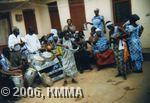
Adowa dance performed in Pankronu Ashanti region





The adowa is a popular dance that is widespread among the Akan and is performed during funerals and public social events. An adowa ensemble comprises a lead singer, a chorus and percussion instruments. The leader and the chorus are nearly always middle-aged women, who accompany themselves with hand-clapping and/or with a dawure double bell or an atoke single bell. The adowa has been studied in detail by Kwabena Nketia in his Folk Songs of Ghana (1963 pp. 88-99).
The dancers use a symbolic language, the different movements of their
hands telling their own story. This body language is accentuated by the use
of a white linen cloth, which they hold in their hand. The short dance steps
are very subtle, drawing attention to the upper part of the body.
This music is characterized by polyrhythmic accents: the dance is in
compound triple time and the accompaniment of the drums is interwoven with
syncopations and cross-rhythms. The bell plays a steady rhythm, to which the
chorus sings the responses. The lyrics of the songs express social and moral
values such as, chiefs who have passed away, the grieving family, sympathy
for the deceased, and the Akan faith.
The adowa percussion ensemble comprises several drums (a pair of
atumpan, an apentemma,
a petia, a brenko
and a donno hourglass drum) and bells (a
dawuru double bell and an
atoke single bell).
The two atumpan drums, tuned to an interval of a fourth or a fifth, are played with two hooked wooden sticks. The largest drum, with the lowest pitch, is associated with the female, while the drum with the highest pitch evokes the male. The atumpan is usually the master drum in the adowa ensemble. The drums are sometimes wrapped in a red cloth. The apentemma drum, which plays a rhythmic ostinato figure in the form of triplets, is struck with the hands.
Traditionally red and black are the appropriate colours worn at an Akan funeral and both men and women wear black sandals. The women also wrap a red or black cloth around their head.
© RMCA/Dominik PHYFFEROEN